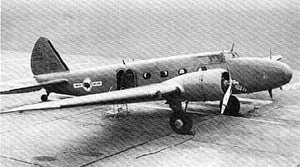| Boeing 247 | ||
|---|---|---|
 A Boeing 247D | ||
| Description | ||
| Role | Passenger & military transport/trainer | |
| Crew | 3 | |
| Passengers | 10 | |
| First flight | February 8, 1933 | |
| Entered service | ||
| Manufacturer | Boeing | |
| Produced | 75 | |
| Dimensions | ||
| Length | 51 ft 7 in | |
| Wingspan | 74 ft 0 in | |
| Height | ||
| Wing area | ||
| Weights | ||
| Empty | ||
| Loaded | ||
| Maximum takeoff | ||
| Powerplant | ||
| Engine | 2 × P&W Wasp | |
| Power (each) | 500 hp | |
| Performance | ||
| Maximum speed | 200 mph | |
| Cruising speed | 189 mph | |
| Range | 745 miles | |
| Ceiling | 25,400 ft | |
| Rate of climb | ||
The Boeing 247 was a 1930s commercial transport. It is considered among the first "modern" aircraft. It was also known in military service as the C-73. This plane carried the Stars and Stripes across the finish line in the world's greatest air race: The MacRobertson Air Race. It flew to 3rd place
History
The Boeing 247 was a revolutionary aircraft, first flying on February 8, 1933, and is considered the first modern passenger airliner. It combined in one aircraft a number of important features, such as a gyro panel for instrument flying, an autopilot, pneumatically operated de-icing equipment, a variable-pitch propeller, retractable landing gear, and an all-metal monocoque fuselage.
The higher speed of the Boeing 247 meant that it could make a trip across seven and a half hours shorter than any previous airliner, making for a total flight of twenty hours. 60 of these aircraft were flown by Boeing Air Transport, with 10 more going to United Aircraft, and the remaining to Lufthansa. They remained in civilian use until World War II, when they pressed into military service as trainers and transports under the designation C-73. Some of these aircraft were still flying into the 1960s.
In civilian use, the Boeing 247 was replaced by the Douglas DC-2.
Notable Events
On October 10, 1933, a Boeing 247 was the victim of the first confirmed case of sabotage of a commercial airliner. A United Airlines aircraft flying from Cleveland to Chicago was destroyed by a nitroglycerin-based explosive device over Chesterton, Indiana.
Existing aircraft
Some existing 247s at museums:
| Serial | c/n | Info |
| CF-JRQ | 1699 | National Museum of Science and Technology, Rockcliffe, Canada. Donated to the Museum in 1967 by California Standard Oil of Calgary, Alberta |
| N18E | 1722 | Science Museum store, Wroughton, UK |
| N13347 | 1729 | Museum of Flight, Paine Field, Washington, USA. Airworthy |
| NC13369 | 1953 | National Air and Space Museum, Washington DC, USA. (Marked as NR257Y) |
Trivia
- In 1933 after 247's first flight, a Boeing engineer, unsurprisingly incorrect, said that there would never be any aircraft bigger than this.